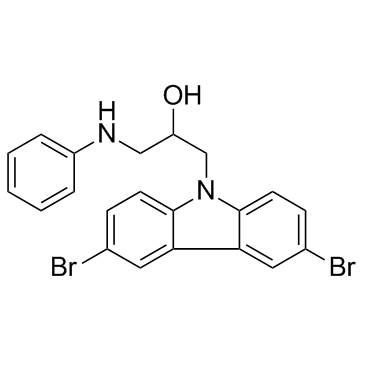301353-96-8
| Name | 1-anilino-3-(3,6-dibromocarbazol-9-yl)propan-2-ol |
|---|---|
| Synonyms |
P7C3
1-(3,6-Dibromo-carbazol-9-yl)-3-phenylamino-propan-2-ol 1-Anilino-3-(3,6-dibromo-9H-carbazol-9-yl)-2-propanol 9H-Carbazole-9-ethanol, 3,6-dibromo-α-[(phenylamino)methyl]- 1-(3,6-dibromo-9H-carbazol-9-yl)-3-(phenylamino)propan-2-ol 1-Anilino-3-(3,6-dibromo-9H-carbazol-9-yl)propan-2-ol |
| Description | P7C3 is a NAMPT activator. P7C3 can enhance learning and memory in aged rats. Protects newborn neurons in the dentate gyrus by mitigating cell death. In vitro: Administration of active P7C3 chemicals to cells treated with doxorubicin, which induces NAD depletion, led to a rebound in intracellular levels of NAD and concomitant protection from doxorubicin-mediated toxicity. In vivo: P7C3 is orally bioavailable, crosses the blood-brain barrier, and is non-toxic at doses several fold higher than the efficacious dose.An easily administered pro-neurogenic compound. The administration of P7C3 is 10mg/ kg( IP) in rats. Administration of P7C3 to normal mice, as well as npas3-/- mice, enhance survival of neurons subsequent to their birth in the SGZ. |
|---|---|
| Related Catalog | |
| References |
| Density | 1.6±0.1 g/cm3 |
|---|---|
| Boiling Point | 656.4±55.0 °C at 760 mmHg |
| Molecular Formula | C21H18Br2N2O |
| Molecular Weight | 474.188 |
| Flash Point | 350.8±31.5 °C |
| Exact Mass | 471.978577 |
| PSA | 37.19000 |
| LogP | 6.60 |
| Appearance | white solid |
| Vapour Pressure | 0.0±2.1 mmHg at 25°C |
| Index of Refraction | 1.687 |
| Storage condition | -20℃ |
| Symbol |


GHS05, GHS06 |
|---|---|
| Signal Word | Danger |
| Hazard Statements | H301-H318 |
| Precautionary Statements | P280-P301 + P310-P305 + P351 + P338 |
| RIDADR | UN 2811 6.1 / PGIII |
| HS Code | 2933990090 |
| HS Code | 2933990090 |
|---|---|
| Summary | 2933990090. heterocyclic compounds with nitrogen hetero-atom(s) only. VAT:17.0%. Tax rebate rate:13.0%. . MFN tariff:6.5%. General tariff:20.0% |
